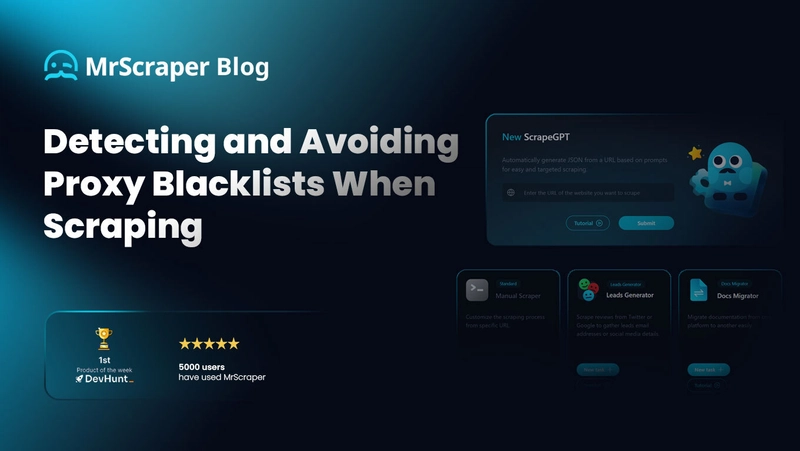When web scraping, proxies can get blacklisted if a website detects suspicious activity. Detecting and avoiding proxy blacklists ensures uninterrupted access and reduces the risk of getting blocked.
Use Case: Preventing IP Blacklisting While Scraping E-commerce Prices
An e-commerce intelligence firm scrapes competitor pricing data daily. Their proxies risk being blacklisted due to frequent requests. By monitoring for blacklists and rotating proxies, they maintain seamless data collection.
How to Detect if a Proxy is Blacklisted
1. Check HTTP Response Codes
Certain HTTP status codes indicate blacklisting:
- 403 Forbidden – The IP is blocked from accessing the site.
- 429 Too Many Requests – The site has rate-limited the IP.
- 503 Service Unavailable – Temporary or permanent block due to bot detection.
Example: Checking HTTP Status Codes
import requests
proxy = {"http": "http://proxy-provider.com:port", "https": "http://proxy-provider.com:port"}
url = "https://example.com"
response = requests.get(url, proxies=proxy)
print(response.status_code)
2. Monitor for CAPTCHA Challenges
If a website consistently serves CAPTCHA challenges, the proxy is likely flagged.
Example: Detecting CAPTCHA
from bs4 import BeautifulSoup
soup = BeautifulSoup(response.text, "html.parser")
if soup.find("div", {"class": "captcha"}):
print("CAPTCHA detected. Proxy may be blacklisted.")
3. Use an IP Blacklist Checker
Check if your proxy IP is blacklisted using services like:
- Spamhaus
- IPVoid
- WhatIsMyIP
Example: Using an API to Check Blacklists
Some services offer APIs to check if an IP is blacklisted:
import requests
api_url = "https://api.blacklistchecker.com/check?ip=your_proxy_ip"
response = requests.get(api_url)
print(response.json())
How to Avoid Proxy Blacklisting
1. Rotate Proxies Automatically
Using a proxy rotation service ensures your IPs do not get flagged.
Example: Rotating Proxies in Python
import random
proxies = [
"http://proxy1:port",
"http://proxy2:port",
"http://proxy3:port"
]
proxy = {"http": random.choice(proxies), "https": random.choice(proxies)}
response = requests.get(url, proxies=proxy)
2. Use Residential or Mobile Proxies
Residential and mobile proxies are harder to detect compared to datacenter proxies.
3. Implement User-Agent and Header Spoofing
Randomizing request headers helps avoid detection.
Example: Spoofing User-Agent
headers = {
"User-Agent": "Mozilla/5.0 (Windows NT 10.0; Win64; x64) AppleWebKit/537.36 (KHTML, like Gecko) Chrome/114.0.0.0 Safari/537.36"
}
response = requests.get(url, headers=headers, proxies=proxy)
4. Introduce Random Delays Between Requests
Adding random delays prevents triggering rate limits.
import time
import random
time.sleep(random.uniform(1, 5))
5. Use CAPTCHA-Solving Services
If a site presents CAPTCHAs, integrating a solver like 2Captcha or Anti-Captcha can help.
Conclusion
Detecting and avoiding proxy blacklists is crucial for effective web scraping. By monitoring HTTP responses, using blacklist checkers, and implementing proxy rotation, scrapers can maintain uninterrupted access.
For an automated and AI-powered solution, consider Mrscraper, which manages proxy rotation, evasion techniques, and CAPTCHA-solving for seamless scraping.



Top comments (0)